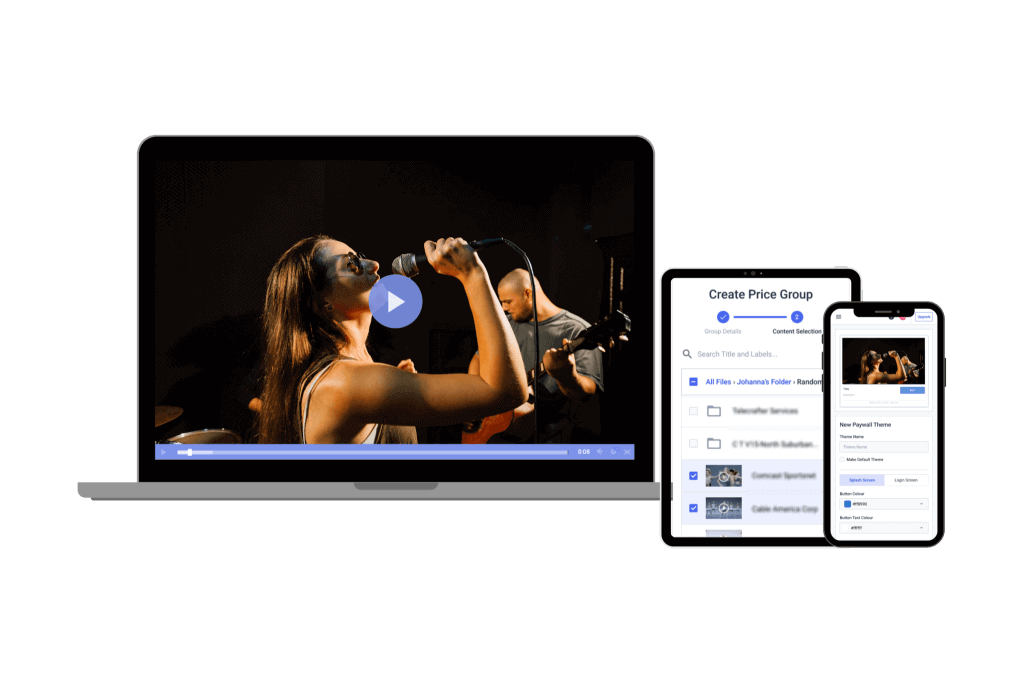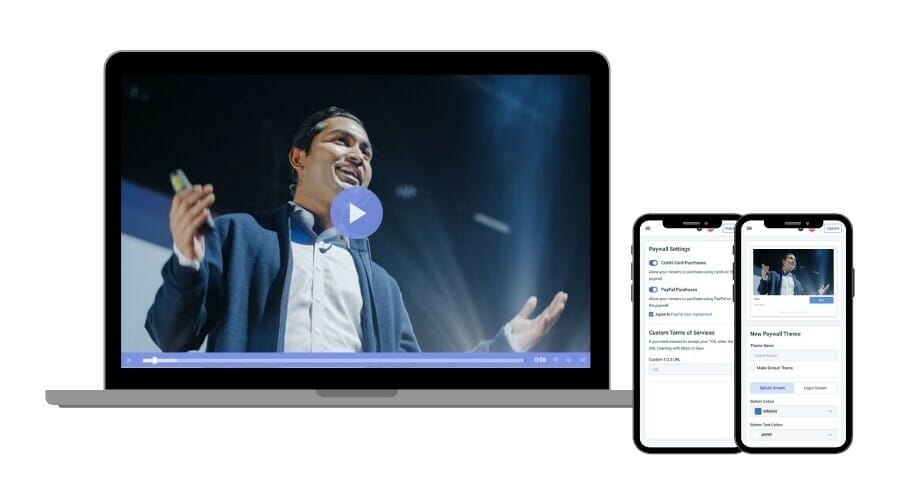Live Video SEO: What Digital Marketers Need to Know in 2025
Live video SEO is no longer optional—it’s essential for marketers who want their content to show up in AI-powered search results in 2025. As search shifts toward real-time answers and personalized feeds, platforms like Google’s Search Generative Experience (SGE) and TikTok are becoming discovery engines for live and short-form video. To stay visible, marketers must learn how to optimize live streams using structured data, smart metadata, and generative engine optimization (GEO) techniques.
In this guide, we break down the core strategies for video SEO 2025, including SEO for live streaming, video contentdiscoverability, and how to repurpose live content for long-term rankings. You’ll also learn how to use tools like video transcripts, JSON-LD markup, and video sitemaps to improve your live video optimization, plus why platforms like Dacast are leading the way with built-in SEO features.
TikTok is now the top search engine for Gen Z, and Google’s SGE is reshaping how live videos get indexed and ranked.
Table of Contents
- What is SEO?
- What is Live Video SEO?
- Using SEO to Drive Traffic to Your VOD Platform
- 12 Steps to Better Live Video SEO in 2025
- Video SEO and YouTube
- What About GEO?
- FAQs
- Conclusion
What is Live Video SEO?

Live video SEO is the process of making live streams more discoverable on search engines and social platforms like Google, YouTube, and TikTok. In 2025, it goes beyond keywords to include AI-first indexing, Google’s Search Generative Experience (SGE), and structured data like JSON-LD and video sitemaps.
Unlike VOD SEO, which builds long-term visibility, live stream SEO focuses on real-time discoverability—helping people find your stream while it’s happening. Optimizing titles, metadata, transcripts, and engagement signals can boost your ranking during a live event. Platforms like Dacast support embedded SEO tools to make this easier.
Voice search and AI assistants now drive more live video queries, especially for local or time-sensitive content. GEO (Generative Engine Optimization) also matters: Google SGE prioritizes videos that answer questions in the moment, making live streams ideal for instant visibility.
VOD SEO still plays a role in repurposing live content into YouTube Shorts or TikTok clips. But in 2025, improving live video SEO means focusing on search visibility during the event, using structured data, real-time metadata, and AI-enhanced tools to stand out.
What is SEO?
SEO, or Search Engine Optimization, is the process of improving a website or content so it ranks higher in search engine results. The goal is to increase visibility and attract more organic (unpaid) traffic from platforms like Google, Bing, or YouTube.
Let me know if you’d like a version focused on video SEO or live stream SEO.
How Live Video Boosts SEO

From an SEO perspective, there is a positive benefit to live streaming. The user-friendly and engaging aspect of live streaming appeals to the qualitative determinants of search engine algorithms. The industry publication MarketingWeek says that live streaming “is key to building authenticity.”
This is because live streaming entails a key interactive element that most content lacks. It provides a more lifelike experience with a community environment. We have seen major search engines like Google and Facebook prioritizing live streaming content over the past several years for this reason. It’s exciting and engaging to audiences. This drives the best type of organic traffic. In other words, when used effectively, live video marketing can bring your content to a warm audience and build a loyal online community. This is the foundation of an effective video SEO strategy and will almost certainly result in more website traffic from qualified leads.
Live video content can drive more visibility in search results, especially when it leads to strong viewer interaction. Search engines like Google use engagement signals to help decide which content deserves top placement. The more people watch, comment, and share during a stream, the more likely it is to rank well.
Here’s how engagement helps improve search visibility for live video:
- Longer watch time signals relevance and quality, which boosts your stream’s ranking.
- Real-time comments and reactions show active engagement, a key metric for video SEO in 2025.
- Live chat activity may now be indexed or used by Google’s Search Generative Experience (SGE) to generate AI-powered summaries and snippets.
- Shares and reposts increase your video’s reach, leading to more backlinks and discoverability.
- High engagement rates across platforms like TikTok Live and LinkedIn Live can boost your visibility inside those platforms—and in Google search.
For even greater impact, platforms like Google now support structured data for live events using JSON-LD markup. This lets you flag upcoming or in-progress streams with Google’s Live Event schema, helping your video show up in rich results and SGE answers.
Want to show up faster in search? Use Dacast’s built-in features like video sitemaps, AI metadata tools, and JSON-LD support to optimize your live streams for both traditional search engines and new AI-driven engines like Google SGE. Whether you’re focused on video marketing SEO or looking to master live stream SEO, engagement and discoverability go hand in hand.
Using SEO to Drive Traffic to Your VOD Platform
Beyond live video marketing, search engine optimization can help you increase the viewership of your video-on-demand(VOD) content. Again, broadcasting videos drives more traffic than text-only web pages and blog posts.
There is a reciprocal element at work here, as well. Good video content improves SEO, creating a better user experience, and drives more traffic to your site. At the same time, good SEO optimization of your other web pages and content will drive more traffic to your videos.If you sell VOD content, whether it be in the form of a streaming service like Netflix or an all-access fitness training VOD platform, SEO optimization can help to increase the traffic to your site and boost your revenue.
Your live video doesn’t lose value once the stream ends. With smart video content SEO, you can turn replays into a steady source of organic traffic. This works especially well for VOD platforms, where searchable content stays relevant.
For example, a fitness brand streams live workouts, then edits them into short VOD clips with targeted titles, transcripts, and structured data for video SEO. By focusing on real search terms—like “morning yoga 10 minutes”—they boost visibility and drive ongoing conversions. This shows the impact of repurposing live video for better SEO.
You can go a step further with simulive streaming, which replays recorded content as live. It refreshes engagement and improves video discoverability, especially when paired with JSON-LD video markup to surface video snippets in search.
In 2025, improving your VOD strategy means using the right formats and tools. Platforms like Dacast offer built-in SEO features like sitemaps, AI video metadata tools, and custom tags to help with live video search optimization, Google Search Generative Experience (SGE), and voice search and video SEO.
Whether you’re exploring YouTube Shorts SEO vs TikTok Live SEO, or learning how to improve live video SEO in 2025, searchable VOD is key to long-term success.
12 Steps to Better Live Video SEO in 2025

Now that we’ve covered what live video SEO is and why it is so important, let’s talk about how to improve your video SEO, especially in the context of marketing for live streaming.
Here is a list of eleven things you can implement right away to optimize your content.
1. Target Keywords
The first step of creating a video SEO strategy is to determine what keywords you’ll target. Essentially, keywords are the terms that your target audience is likely to enter into a search engine.
This is a big part of SEO marketing, and it’s an art and a science. There are several ways to conduct keyword research. You can start out with a low-budget tool like Keywords Everywhere.
Make a list of keywords that you think your target audience would be searching for. If you have no idea where to start, feel free to survey your audience and ask them what sort of topics they’d be interested in learning about or what they would find valuable.
Plug the keywords into your keyword tool to check out the search volume, cost per click (CPC), and competition/difficulty. There is no right or wrong way to choose a keyword, and what qualifications you use should depend on your specific goals.
If you are just starting out, you’re going to want to start with easy keywords with low competition. On a scale of 1 to 100, less than 20 is ideal. If your tool’s scale is 0 to 1, less than 0.2 is ideal.
As for volume, different SEO specialists take different approaches. Search results volume of 0 searches per month isn’t great. A search volume of 100 or even lower could work, but higher is often better. Essentially, you just want to know that the keyword is generating some traffic so that you’re not wasting your time or resources on a dead keyword.
Once you choose viable keywords, there are other SEO ranking factors you should consider. Do a quick Google search to see if Google is already ranking videos for that search query. Your video has a better chance of ranking for keywords that are already ranking video content, so keep that in mind as you compile your list.
Once you have your final list of keywords, make sure you optimize them throughout the video description and content. They should be in the meta description, meta titles, and title tags of your videos as this increases the chances of ranking on search engine results pages for those particular keywords.
2. Title Properly
Use a descriptive, compelling title for all your videos. Try to include relevant keywords in every video title.
Your title should entice viewers to click, but it should not be “clickbait” or misleading. Accurately describe what the video entails so that the algorithm can show it to viewers who would find it relevant and useful.
3. Descriptions
Take the time to write a thorough description of each of your videos. This should include the topic of the video, what sort of material is included, etc. Links to other blog posts and videos can also show the algorithm that the bodies of work are related.
Consider including a bio of anyone in the video and other relevant information. Keep it concise but highly relevant and again, include keywords and phrases.
4. Make Great Content
While the strategic usage of keywords is essential, what’s even more important is creating great content that keeps viewers engaged. Creating content that your viewers engage with can help its organic search results ranking.
Some specific metrics may affect your search results ranking, including:
- Watch time and session time
- Click-through rate (CTR)
- Viewer retention
- Other engagement metrics
Keeping these metrics up all comes down to creating videos that provide the value that you’ve promised.
Some experts suggest putting a special focus on the first 15 seconds of your video since that is where you will capture the viewers’ attention. Consider using those 15 seconds to showcase highlights of the video in the style of a preview reel.
5. Video Hosting Platform

Selecting the right video hosting platform can give you access to more SEO tools to make this process easier. Dacast includes a range of search engine optimization tools for video via our advanced streaming platform for video publishers.
Use your video hosting platform’s settings to turn on a video sitemap to improve indexing. Check if your video marketing platform uses JSON-LD, which is a more technical element of video SEO. Note that not all video hosting platforms include this feature.
If you’re interested in accessing our unified streaming solution, please contact us.
6. Thumbnail
Use a compelling thumbnail image to increase traffic to your website and drive conversions. Include eye-catching images and text that describes the contents of the video. While a search engine might not be able to scan the in-video text, this aspect plays into the user-friendliness that search engines favor.
Keep in mind that “eye-catching” is not synonymous with “clickbait.” Make sure that the content in your video is on par with what you advertise.
7. Context
Any web page you embed your video on should also be optimized for the search engine in mind. Use relevant keywords, create high-quality content, and implement technical SEO suggestions for websites. Take time to create valuable content around your embedded video.
An SEO specialist and content creator can help you optimize the posts and landing pages that house your video content. They can also help you optimize your entire website for the best performance.
8. One Video Per Page/Post
Google search results typically only show the first video embedded on any web page. Therefore, put your best and most high-traffic content at the top of the page, above any other videos.
In fact, we recommend one video per landing page as a general SEO tip.
9. Transcript
Consider including closed captioning or an entire transcript in the description of your video. This text makes your content “machine-readable” and easier for search engines to index.
Including a transcript may also make your content more accessible to those who are hard of hearing or have other similar impairments.
10. Optimize Your Structured Data
You must also consider the technical aspect of video SEO and this includes optimizing video structured data. Structured data makes it easy for Google and other search engines to understand your video content and index accordingly.
You can optimize structured data by implementing video schema markup. This involves using Schema.org markup to embed structured data in the web pages where your video content will be published.
The structured data provides search engines with the necessary details about your video content, including description, title, and thumbnail URL.
Always use validation tools like Microsoft Bing Markup Validator to test your HTML tags and check the validity of your structured data.
Doing this will help you find any errors in your video structured data, allowing you to further improve it.
11. Use Other Channels
SEO is an important part of live video marketing and modern marketing in general. However, it’s only one part, so you should pair it with other marketing tools. Use your newsletter, blog, email outreach, affiliate marketing, influencer marketing, and other methods to promote your content.
12. Assess and Revamp
Video SEO is a long-term game that requires tweaking and improving over time. In order to keep track of what Google is ranking your video content for, it is important to set up Google Analytics and monitor your results.
Sometimes, search engines rank your content for terms that you didn’t expect when you originally optimized it. If you notice that Google is picking up different keywords than you had intended, consider re-optimizing your content accordingly.
You could simply add context or the new keywords, or you can shift the focus of the content. With video SEO, you’ll likely just add context to the new keywords since changing the context in your video would require editing and reuploading your video.
If your focus is on search engine optimization for live streams, the time-sensitivity of the event might feel a little contradictory to this tactic. However, you can upload a recording of the original stream to the landing page that housed the stream. This will help you to continue to engage with your audience and generate revenue after your stream has ended and also increase your ranking for organic search results.
New Substeps to Boost Live Video SEO in 2025
Use AI metadata tagging tools
Leverage tools that automatically generate chapters, label speakers, and identify key moments. This helps search engines and AI platforms better understand your content, making it more discoverable.
Coordinate metadata across platforms
Keep your titles, descriptions, and tags consistent when streaming to YouTube, TikTok, LinkedIn, and other platforms. This improves credibility and visibility in search results across the web.
Create short-form clips from your live stream
Break your live stream into bite-sized clips tailored for TikTok, YouTube Shorts, or Instagram Reels. These snippets can boost exposure and direct viewers back to your full content.
Optimize for voice search
Use natural, conversational phrasing in your titles and descriptions to match how people speak into devices. This helps your content show up in smart assistant results.
Update structured data markup tools
Use the latest tools like Bing Markup Validator, Schema.dev, and Google’s Rich Results Test to validate and improve your video schema for better indexing and rich snippet potential.
Rich Results Test
Take full advantage of Dacast SEO tools, built-in SEO features, such as JSON-LD structured data, automated video sitemaps, and platform-level metadata support to boost your live and on-demand visibility.
Video SEO and YouTube

YouTube, owned by Google, plays a key role in both YouTube and Google search results, including the new Google Search Generative Experience (SGE). YouTube Shorts and live videos are increasingly featured in SGE, making YouTube essential for SEO live strategies.
While uploading all your videos to YouTube might seem like a good way to increase visibility, it can split traffic between your site and YouTube, which may hurt your overall video SEO optimization. YouTube also has limits for business use: branding, monetization, and security options are restricted, and you don’t fully own your content.
A better approach is to use YouTube for short clips and teasers to attract viewers, then drive traffic to your own site where you host full videos or live streams on platforms like Dacast. This gives you better control and SEO benefits.
YouTube keyword research differs from traditional Google SEO because search behavior is unique. Popular Google keywords may not work well on YouTube. In 2025, top tools include:
- YouTube Studio Analytics – now offers deeper insights for optimizing live streams for Google SGE.
- TubeBuddy – enhanced with AI-driven keyword suggestions.
- VidIQ – integrates AI for topic research and competition analysis.
- Morningfame – focuses on keyword effectiveness and growth.
- Ahrefs YouTube Keyword Tool – detailed YouTube-specific search data.
Success depends on channel authority (subscriber base, watch time) and video-level signals (engagement like comments and watch duration). These help YouTube and Google SGE rank your videos higher.
YouTube vs TikTok vs LinkedIn for SEO
| Feature | YouTube | TikTok | |
|---|---|---|---|
| Live SEO Support | Strong; ranks on YouTube & Google SGE | Growing; mostly in-app visibility | Moderate; B2B focus, indexed by Google |
| SEO Tools | YouTube Studio, TubeBuddy, VidIQ, Ahrefs | TikTok Creator Tools; limited third-party | LinkedIn Analytics; few third-party tools |
| Discoverability | High; videos rank in Google & YouTube | Moderate; strong in-app, limited on search | Moderate; good for professional keywords |
| Channel Authority | Very important | Emerging | Important for company/personal pages |
| Best Use | Long-form, webinars, live events | Short clips, trends, live chats | Professional content, B2B webinars |
| GEO Impact | Strong with structured data | Growing via geo-tags and trends | Moderate via location tagging |
Using YouTube with a professional platform like Dacast lets you combine reach with brand control. Dacast supports JSON-LD markup, video sitemaps, and video analytics to improve GEO and video content discoverability in 2025’s AI-driven search world.
What About GEO?
Generative Engine Optimization, or GEO, is becoming an important part of video SEO in 2025. As AI platforms like Google’s Search Generative Experience (SGE) evolve, they do more than just scan text—they analyze video content in new ways to understand what’s inside your live streams and videos.
AI-powered systems can now index videos by recognizing spoken words, visual elements, and even the context of the content. This means that optimizing your live streams for these engines can improve your chances of being discovered in AI-driven search results. GEO helps make your video content more visible by feeding the right signals to AI platforms, ensuring your live videos rank better not only on traditional search but also in generative search experiences.
To dive deeper into how GEO works and how you can optimize your video content for it, check out our full guide on Generative Engine Optimization and video content discoverability.
FAQs
1. What is live video SEO?
The process of optimizing live streams and other video content with the aim of increasing their search engine visibility is called search engine optimization, otherwise known as “SEO”.
2. What is the best video format for SEO?
It is advisable to upload your videos in formats such as 3PG, AVI, MKV, MP4, VOB, WebM, WMV, MPEG, M4V, XAP, OGV, RAM, RM, ASF, DivX, and M3U8. These are widely supported video formats that increase the chances of your video content being indexed by search engine crawlers and optimize your SEO efforts.
3. How do you monetize live videos?
You can monetize live videos through affiliate marketing and sponsored ads. You can also add a paywall to your videos and charge viewers before giving them access.
4. How to do SEO for my YouTube video?
Implementing search engine optimization for YouTube videos involves:
- Using your keyword in the video title, description, and tags
- Adding transcripts and close captions
- Using hashtags to widen the reach of your videos
5. How do I find SEO keywords for YouTube?
The goal of YouTube keyword research is to find popular search terms you can create video content for. Here are some tips to guide your research:
- Analyze competing videos for keywords
- Leverage YouTube keyword research tools
- Create a keyword map
- Create keywords based on your audiences’ search intent
6. What is live video SEO and how is it different from regular video SEO?
Live video SEO focuses on optimizing real-time streaming content to improve visibility during broadcasts, while regular video SEO targets pre-recorded videos for ongoing discoverability.
7. How does live video appear in Google SGE and other AI-powered search engines?
Live videos can be featured prominently through rich snippets, structured data, and real-time engagement signals, helping AI-driven engines like Google SGE highlight timely, relevant content.
8. What platforms support live video SEO best in 2025?
Platforms like YouTube, TikTok, LinkedIn, and Dacast offer strong live video SEO support with features like structured data, analytics, and optimized playback for search engines.
9. How can I optimize my live streams for voice search?
Use clear, natural language in titles and descriptions, add detailed metadata, and include transcripts or captions to improve voice search discovery.
10. What’s the difference between SEO and GEO for video content?
SEO focuses on overall search engine visibility, while GEO (Generative Engine Optimization) targets optimizing video content specifically for AI-driven engines and personalized, context-aware search results.
Conclusion
In 2025, SEO live strategies are essential for digital marketers aiming to boost video content discoverability. Optimizing live streams for Google SGE and leveraging the latest best SEO practices for live streaming content make your videos easier to find and more engaging. Incorporating GEO—Generative Engine Optimization—helps tailor your live videos to local audiences, increasing reach and relevance.
With simple video SEO optimization steps like using structured data markup and clear metadata, marketers can improve rankings across platforms and AI-powered search engines. Platforms like Dacast provide built-in SEO tools and analytics that make optimizing and hosting live video straightforward, helping you get the most from your streaming efforts.
As we mentioned, it is important to choose a video platform that offers video SEO tools. Dacast is an award-winning OVP that does just that. Our platform offers advanced live streaming and video hosting solutions trusted by businesses and marketers alike.
Start your free 14-day trial to explore powerful video SEO optimization tools, including structured data markup, sitemap integration, and detailed analytics designed to boost your content’s discoverability. Sign up today to get started—no credit card required.
For exclusive offers and regular tips on live streaming, feel free to join our LinkedIn group.
Thanks for reading, and good luck with your live broadcasts!
 Stream
Stream Connect
Connect Manage
Manage Measure
Measure Events
Events Business
Business Organizations
Organizations Entertainment and Media
Entertainment and Media API
API Tools
Tools Learning Center
Learning Center Support
Support Support Articles
Support Articles